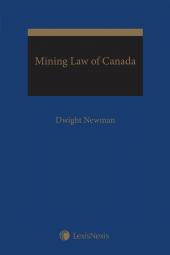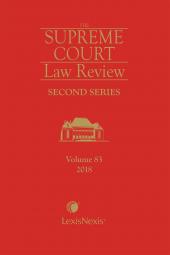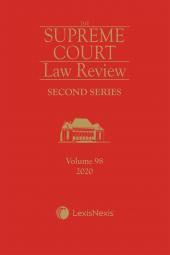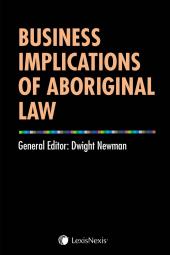Mining Law of Canada
A contemporary take on mining law in Canada, this text not only considers traditional topics like property issues on mineral acquisition, but also explores more recent additions to the mining law conversation, such as Indigenous rights and other claims by communities.
One Year Subscription Only Terms
Subscribers receive the product(s) listed on the Order Form and any Updates made available during the annual subscription period. Shipping and handling fees are not included in the annual price.
Subscribers are advised of the number of Updates that were made to the particular publication the prior year. The number of Updates may vary due to developments in the law and other publishing issues, but subscribers may use this as a rough estimate of future shipments. Subscribers may call Customer Support at 800-833-9844 for additional information.
Subscribers may cancel this subscription by: calling Customer Support at 800-833-9844; emailing customer.support@lexisnexis.com; or returning the invoice marked 'CANCEL'.
If subscribers cancel within 30 days after the product is ordered or received and return the product at their expense, then they will receive a full credit of the price for the annual subscription.
If subscribers cancel between 31 and 60 days after the invoice date and return the product at their expense, then they will receive a 5/6th credit of the price for the annual subscription. No credit will be given for cancellations more than 60 days after the invoice date. To receive any credit, subscriber must return all product(s) shipped during the year at their expense within the applicable cancellation period listed above.
Product description
"Mining Law of Canada, exquisite and loaded with lots of information, is indeed a grand display of Dwight Newman’s versatility as a consummate law scholar...[I]n an intriguing way the book reveals the multifarious dimensions of issues in mining law, and demonstrates the linkage the subject has with some complex areas of law, particularly with the area of conflict of laws...
An important credit deservingly ascribed to this book is that it has proven to be an invaluable resource on Canadian mining law, and provides a useful template for designing a modern syllabus on the subject."
Reviewed by Martin-Joe Ezeudu, Assistant Professor
Bora Laskin Faculty of Law, Lakehead University
See the review in Journal of Energy & Natural Resources Law, Volume 37 Issue 3
With some of the world's richest mineral reserves, Canada is a mining superpower – yet very few books dedicated to mining law grace the shelves of Canadian law libraries. That is about to change with the publication of Dwight Newman's new treatise, Mining Law of Canada. Offering a contemporary take on mining law in Canada, this text not only considers traditional topics like property issues on mineral acquisition, but also explores more recent additions to the mining law conversation, such as Indigenous rights and other claims by communities.
A comprehensive overview
Mining law provides a legal structure for the exploration for and development of mineral resources, as well as a system for maximizing the economic value that the industry can produce while complying with an appropriate regulatory framework. Given this broad mandate, mining law draws on a range of practice areas – from property law and constitutional law, to Aboriginal law and environmental law, to securities law and even international criminal law.
This text offers a comprehensive overview of these different aspects of mining law, and includes discussions about mineral rights, transactional provisions, foreign investment issues, financing and securities, mining operations, relevant taxation matters and extraterritorial regulation of Canadian mining companies working abroad.
In particular, Mining Law of Canada features expert commentary and in-depth analysis on the current state of mining law legislation and jurisprudence, including precedent-setting case law. As a result, it is a very useful reference for mining lawyers and professionals.
A practical guide
Mining Law of Canada is an essential resource for in-house, government and outside counsel who regularly work in the mining, natural resources and related practice areas, including:
- Lawyers specializing in mining and environmental law who require a reference guide to all matters related to mining
- In-house lawyers who want to reduce their reliance on outside counsel
- Government lawyers who are looking for up-to-date information and analysis on the current state of the law
- Law libraries that can provide a valuable resource to lawyers who only deal with mining and/or property rights occasionally and to professors as well as law or graduate students who are conducting academic research in this practice area
Table of contents
CHAPTER 1: INTRODUCTION
1. Background to Mining Law of Canada
2. Structure of the book
3. Federal, provincial, and territorial jurisdiction
4. Jurisdiction on Aboriginal lands and emerging issues on Aboriginal jurisdiction
5. Legal reforms and the mining industry
CHAPTER 2: MINING AND COMMUNITIES
1. Introduction
2. Constitutionalized Aboriginal and treaty rights in Canada
3. Aboriginal title and other forms of Indigenous land ownership
4. The duty to consult
5. Debates concerning FPIC
6. Indigenous-industry agreements and economic participation of Indigenous communities in mining developments
7. Possible ramifications of anti-bribery provisions and extractive sector transparency legislation for Indigenous communities
8. The meaning of and possible legal ramifications of ‘social licence'
CHAPTER 3: THE LAW AND THE MINING CYCLE1. The importance of an integrated understanding of the mining industry
2. The mining cycle and interactions with law
3. Complex roles of mining law
CHAPTER 4: OWNERSHIP OF MINERALS IN CANADA
1. Introduction
2. Crown minerals on Crown land
3. Crown minerals on private land
4. Private freehold minerals on private land
5. Inherent Indigenous ownership of minerals
6. Indigenous ownership of minerals under modern treaties
7. Indigenous royalties and resource revenue shares
CHAPTER 5: ACQUISITION OF MINERAL RIGHTS THROUGH PROSPECTING
1. Introduction
2. Historical background to traditional free entry systems
3. Traditional free entry systems
4. Contemporary Canadian free entry systems and ministerial discretion systems
5. Theory of rights purchase systems for oil and gas and inapplicability of such systems in context of other minerals
6. Shift to online staking
7. Modern constitutional and policy issues on free entry systems
CHAPTER 6: SURFACE RIGHTS ISSUES
1. Introduction
2. Surface access by consent or agreement
3. Statutory surface rights access
4. Compensation
5. Provincial jurisdiction via surface rights leases
CHAPTER 7: THE WITHDRAWAL OF LAND FROM MINING ACCESS
1. Introduction
2. General provisions for withdrawal of lands from mining access
3. Creation of parks
4. Indigenous lands and land issues
5. Expropriation and compensation issues
CHAPTER 8: DEALINGS IN MINERAL RIGHTS
1. Introduction
2. Law concerning transfer of mineral interests
3. Further considerations concerning dealings in mineral interests
4. Implications of characterization of mineral interests for transfers
5. Abandonment and forfeiture
CHAPTER 9: RESTRICTIONS ON FOREIGN INVESTMENT
1. Introduction
2. Investment Canada Act framework
3. Examples of application
4. Future developments
5. Special restrictions in the uranium context
CHAPTER 10: FINANCING AND SECURITIES ISSUES
1. Introduction
2. Financing of mineral exploration
3. Financing of mine development
4. Alternative financing arrangements
5. Securities regulation and the role of NI 43-101
CHAPTER 11: THE REGULATION OF MINING OPERATIONS
1. Introduction
2. Environmental Impact Assessment requirements
3. Federal environmental standards bearing on mining operations
4. Provincial and territorial environmental standards bearing on mining operations
5. Other legal standards affecting mining operations
CHAPTER 12: REGULATORY ISSUES ASSOCIATED WITH MINE CLOSURE AND RECLAMATION
1. Introduction
2. Provincial and territorial regulation related to mine closure and reclamation
3. Special considerations in uranium contexts
4. Special challenges of interaction between provincial regulation and federal bankruptcy law
CHAPTER 13: ROYALTIES AND TAXATION
1. Introduction to mining taxation
2. Jurisdictionally variable taxes and royalties
3. Federal income taxes and business structure
4. CEE/CDE/CCA systems
5. Qualifying Environmental Trust (QET)
6. Flow-through-shares
7. Mineral exploration tax credit
CHAPTER 14: SOCIAL RESPONSIBILITY AND EXTRATERRITORIAL REGULATION OF CANADIAN MINING COMPANIES
1. Introduction
2. Anti-bribery regimes
3. Extractive sector transparency legislation
4. Canadian adjudication on extraterritorial torts
5. Corporate social responsibility regimes
6. Future directions in extraterritorial regulation of Canadian mining companies
 Lexis Nexis
Lexis Nexis 



